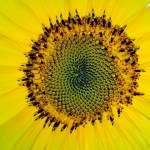
Image by Karin Henseler from Pixabay
I have long been fascinated by the Fibonacci sequence because it seems to show up everywhere. You might have noticed it, that certain swirl that shows up on things. Here are a few examples:




In An Elf’s Equations, Sagara describes it like this:
Start with 1, then add the previous number to it (in that case, 0), then add the previous number to that number… 1, 1, 2, 3, 5, 8, 13, 21… Sagara could describe this elegantly as an equation: xn= xn-1+ xn-2. Not that anyone else she knew appreciated that elegance. She could draw this as a series of blocks, then draw a line through their intersections to make a spiral, the same spiral on snail shells and flower petals and pine cones, even faces. Taking the ratio between any two consecutive numbers in the sequence and averaging them gave Sagara the Golden Ratio, 1.618034, which could usually be simplified to 1.6. This number appears over and over and over again in nature. Sagara’s mother told her it even determined the shape of great storms and swirls of stars in the sky. –pp. 46-47
I think Sagara does an okay job of describing the Fibonacci sequence, but I know someone else who does a spectacular job of explaining it: Vi Hart. Her Doodling in Math Class YouTube series shows just how much fun math can be, and how much it influences art. She has three videos on the Fibonacci sequence. The first is the simplest, Part 2 gets a little more complicated, and Part 3 is very complicated, so see how much you can challenge yourself! I recommend you watch them several times because Vi Hart talks REALLY fast.
- Spirals, Fibonacci, and Being a Plant (Part 1)
- Spirals, Fibonacci, and Being a Plant (Part 2)
- Spirals, Fibonacci, and Being a Plant (Part 3)

Want to find some spirals yourself? Ordinarily, I’d suggest that you go shopping in the grocery aisle of your supermarket and look for pineapples, artichokes, cauliflower, and stalks of brussels sprouts to try out, but since we’re all avoiding grocery stores, go outside! Pine cones, leaves on stalks, flowers (if they’re up and growing in your part of the world), and even acorn caps all have Fibonacci spirals on them. Can you find them? Can you find other spirally things in your yard?
And if you can’t, try drawing slug cats and flowers and pine cones, or come up with new creatures made out of spirals, Sagara, for example, draws spiral dragons.
Tomorrow, I’ll give you a template so you can build your own model of Thea!


Nice Post! thanks